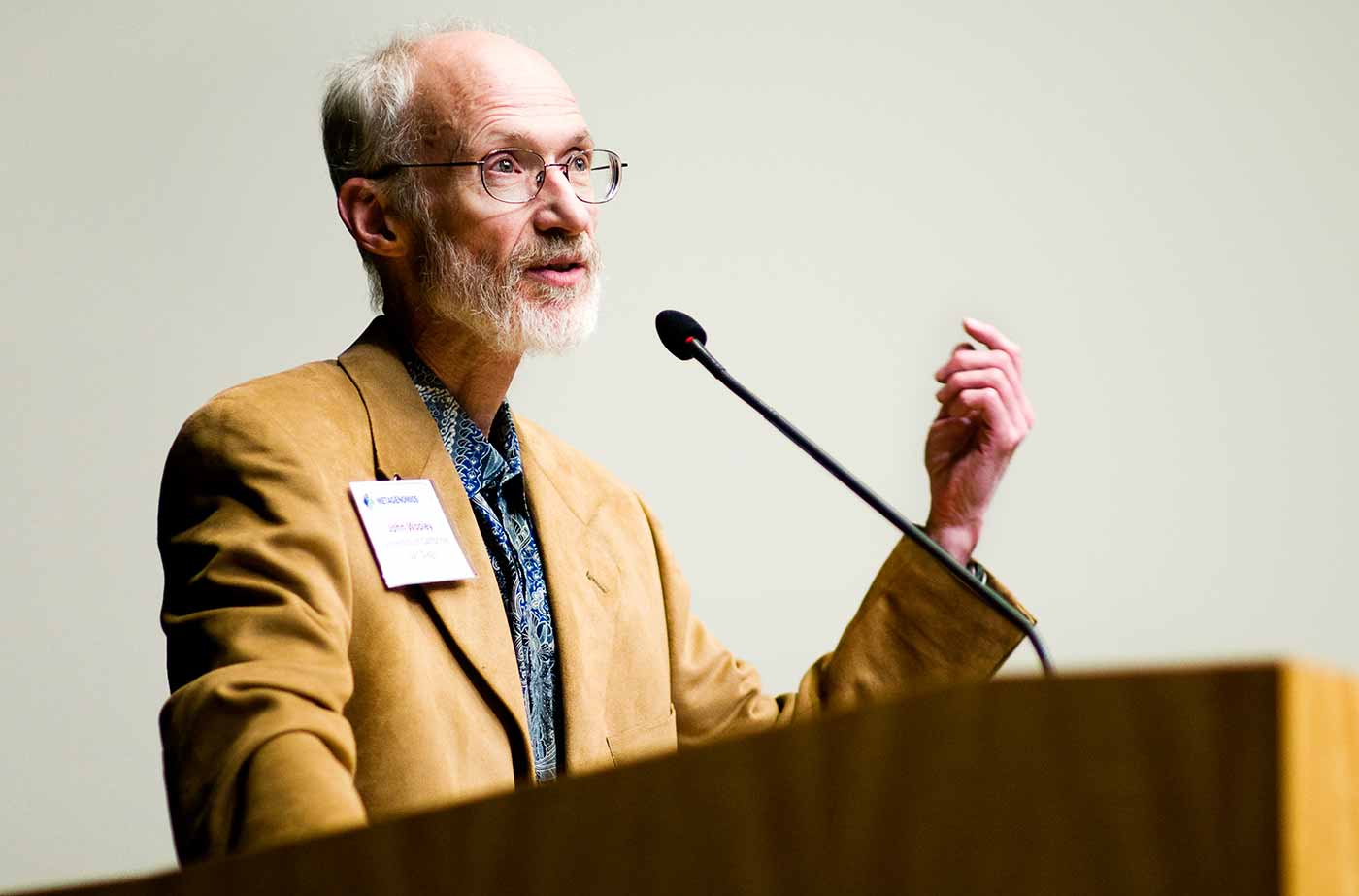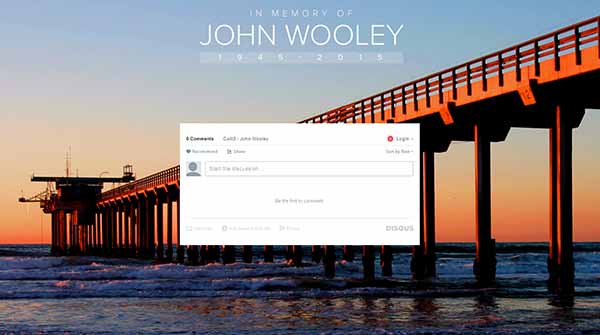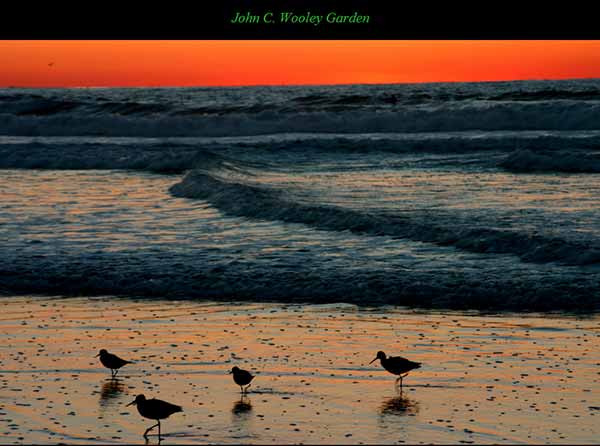
John Wooley: In Memoriam
Published Date
By:
- Doug Ramsey
Share This:
Article Content

John Wooley (1945-2015)
Dr. John Wooley, the long-time associate vice chancellor for research and professor of pharmacology at the University of California, San Diego, passed away in April after a long battle with cancer.
“He had a lifetime of contributions to biology and its digital transformation,” said Larry Smarr, director of the California Institute for Telecommunications and Information Technology (Calit2). “But it was his human touch that made a lasting impact on everyone who knew him.”
“John was a visionary seeing some 35 years ago the necessity of integrating two of the greatest revolutions of the end of the 20th century and the beginning of the 21st century: that of computing and computer science on the one hand, and biological sciences on the other,” recalled longtime colleague Peter Arzberger, now Senior Advisor for Research Cyberinfrastructure at NSF. “As we consider the current biomedical research challenges, we need to look 10 to 20 years into the future, very much as John would have.”
UC San Diego faculty, staff and students were privileged to count John Wooley as a colleague for over 15 years. In 1999 Chancellor Robert Dynes recruited Wooley to join UC San Diego’s administrative leadership given that Wooley was already considered a visionary for his pioneering role in creating government funding programs to overcome the critical information problems faced by biological researchers. In particular, he pointed fellow scientists to a broad range of opportunities for computational science to contribute to experimental biology.
“Meeting these pervasive information challenges is not just the key to all advanced research today,” he said at the time. “It is also the fundamental key which will enable the university to become a community of scholars serving society.”
Wooley earned his Ph.D. in biophysics from the University of Chicago, working with Albert Crewe to build the first high-resolution, scanning-transmission electron microscope and to study the higher-order structure of the genetic material inside of cells. He had received his bachelor’s degree in physics, chemistry and biochemistry from Michigan State University. In 1984, he left a professorship at Princeton to become a program officer at the National Science Foundation (NSF) to take up the challenge of building modern computational biology. While there, he was involved in developing a series of programs for the federal government, from collaborating on the first stages of the genome project to establishing the first federal programs in bioinformatics and in computational biology.
In 1988 he became the founding director of NSF’s new Division of Infrastructure and Resources (now called the Division of Biological Infrastructure). In that capacity, Wooley managed interdisciplinary biology research infrastructure and training programs funded by the NSF.
At a joint NSF meeting of the advisory committees for both Cyberinfrastructure and for Biological Sciences just days after John Wooley’s passing, members remembered his fundamental contributions as a strong advocate for building the interface between all areas of biology and computing broadly. As Arzberger recalls, when Wooley went to the NSF, it was prior to the creation of NSF supercomputing centers to serve all disciplines.
“He understood early the need to make the then-newly-formed NSF supercomputer centers pay attention to the needs of the biological sciences,” recalls Calit2’s Smarr, who was founding director of one of those centers, the National Center for Supercomputing Applications at the University of Illinois, Urbana-Champaign. “I had many discussions with John about how best to nurture the emerging disciplines of computational biology.”
Wooley also helped create new NSF programs to grow a community of biologists, computer scientists, and mathematicians that focused on building algorithms, tools, software and databases used by the biological science communities, across all of biology, from structural biology and neuroscience to the ecological sciences. One resource tracing its funding back to these programs is the Research Collaboratory for Structural Bioinformatics (RCSB) Protein Data Bank (PDB). Managed by Rutgers and UCSD, the PDB serves as a heavily-used global repository and portal into biological macromolecular structures (the 3D structures seen routinely by visitors to Calit2’s StarCAVE virtual-reality environment; see image).
As he was ending his eight years at NSF, Wooley co-edited a seminal workshop report, “Computational Biology: An Overview” (1992). In 1994, Wooley joined the Department of Energy as chief of staff and deputy associate director in its Office of Science. He was responsible for biological and environmental sciences, overseeing biotechnology, molecular and cellular biology, the health effects of radiation and energy production, molecular nuclear medicine, and climate change research. Wooley also coordinated major aspects of the human genome project, including bioinformatics, and led efforts in developing programs for microbial genomes and computational structural biology.
In the late 1990s UCSD’s Mark Ellisman, director of the Center for Research in Biological Systems (CRBS), had advised then-Chancellor Dynes to talk with Wooley when on one of his visits to Washington. Mark believed that hearing Wooley’s perspective on the information-biology interface, and the anticipated data deluge from advanced instrumentation, might help the Chancellor to guide UCSD to become a premier institution for the underlying science and technology in the rapidly growing area of bioinformatics.

Friends and colleagues of John Wooley are invited to contribute thoughts and remembrances in his honor at this discussion board. To upload your comment, go to calit2.net/wooley.
Dynes met with Wooley and they hit it off immediately. UCSD then moved very quickly to recruit him. “John was a visionary who wouldn’t let convention cloud his thoughts,” Dynes recalls. As Associate Vice Chancellor, John worked closed with then-Senior Vice Chancellor for Academic Affairs Marsha Chandler. “From the day John arrived at UC San Diego it was clear that he was an amazing individual. He was an extraordinarily talented scientist and was always brimming with innovative and exciting ideas,” recalled Chandler, now Executive Vice President/Chief Operating Officer of the Salk Institute.
Shortly after he arrived at UC San Diego, Wooley would also be closely affiliated with the effort to win a state competition to create what became the California Institute for Telecommunications and Information Technology (Calit2), whose founding director Larry Smarr had worked closely with Wooley at NCSA. Wooley helped draft portions of the proposal to make biological sciences one of the primary ‘layers’ for early adoption of new information technologies, naming the two-campus (UCSD/UCI) Calit2 initiative “Digitally Enabled Genomic Medicine.”
“I had the opportunity to learn from him the art of bridging disciplines,” recalls Ramesh Rao, director of the Qualcomm Institute (the UC San Diego division of Calit2). “He was able to articulate a soaring long-term vision while keeping a careful eye on securing the relationships and resources needed to recruit and nurture the next generation of researchers.”
Since Calit2 opened its headquarters building at UCSD, Atkinson Hall, in 2005, Wooley has maintained a research presence in the Qualcomm Institute. He focused on “how best to use visualization and high-bandwidth networking in a biological environment,” he wrote, adding that he was focused “on building an integrative biology research environment.”
Wooley’s interest in metagenomics and growing interest in cyberinfrastructure to support biological research led him to become involved with one of Calit2’s largest projects to date: the Community Cyberinfrastructure for Advanced Marine Microbial Research and Analysis (CAMERA), launched in 2006 in partnership with the J. Craig Venter Institute. With funding of nearly $25 million from the Gordon and Betty Moore Foundation, Calit2 director Larry Smarr led the CAMERA project with John Wooley serving as its Chief Science Officer and Mark Ellisman as its Chief Technical Officer.
“The CAMERA project allowed Calit2 to build a global repository and compute facility for uploading of environmental microbial samples that had been metagenomically analyzed,” said CAMERA PI Smarr. “John has been my biology mentor for decades. Without him, I never would have become engaged with environmental and human microbiomes.”
Supporting the CAMERA effort, Wooley created a new conference series focused exclusively on Metagenomics, hosted at Calit2. For the 2008 edition of the workshop, approximately 60 experts made plenary presentations over the course of five weekdays, with conference chair Wooley kicking off the event with a talk on “Setting the Stage: Mobilizing the Metagenomics Community.” [Click here to download a short clip from Wooley’s 2008 opening talk.]
Wooley quickly developed activities around life science and technology, and played a pivotal role in boosting support for funding of computing infrastructure to support scientific research, notably in the biological sciences. He remained a key contributor to building the interfaces between the biological sciences and the computer, computational, and mathematical sciences. He contributed to the Atkins Report on “Revolutionizing Science and Engineering through Cyberinfrastructure” (2003) and the following year produced a report on “Building Infrastructure for the Biological Sciences” (2004).
He was also active and instrumental in several new efforts based at UC San Diego, including the:
- Joint Center for Structural Genomics (JCSG), where, as co-PI, he served as director of the center’s Bioinformatics Core;
- RCN for Genomic and Metagenomic Standards; the
- Interoperable Information Infrastructure for Biodiversity Research (I3BR); and others.
For the period from 2002 to 2006, Wooley also served as a strategic advisor to the San Diego Supercomputer Center. Then in 2006, he was appointed professor of pharmacology in the new Skaggs School of Pharmacy and Pharmaceutical Sciences (while continuing to hold the associate vice chancellor of research title). He also served as an adjunct professor at the Burnham Institute.

Photo of La Jolla sunset, one of more than 400 images by John Wooley and collected online in the "Wooley Garden" of his nature photography. To visit the Wooley Garden, go to: bit.ly/1GWW5Zz
In the Skaggs School, Wooley’s own research focused on structure-function relationships in protein-nucleic acid complexes and the architecture of chromatin and ribonucleoproteins. But as he said at the time, he recognized that “pharmacology should benefit strongly from new computational science thrusts on the campus and from the coordinated effort in structural genomics, a second phase of international genome projects aimed at using physical science tools to uncover the information content of newly discovered genetic information.” Wooley also brought together computational science and experimental pharmacology to explore major questions in the mechanisms for molecular recognition. He was very dedicated to his teaching, which included the ‘Transitional Medicine’ class in the Skaggs School and working with the MD/Ph.D. program.
Wooley also sought to encourage graduate students working across traditional disciplinary boundaries. “Scholars Serving Society” became the title of a series of publications edited by Wooley and longtime colleague Joseph Deken and published by the university to highlight the interdisciplinary research going on at UC San Diego in the first decade of the 21st century. In particular, Wooley was proud of being able to shed light on the work of graduate students through the books, thanks to support from then-Vice Chancellor Marsha Chandler.
“He was an incredibly caring person; no matter how difficult his own health situation became he was always concerned about others. He leaves a broad and deep legacy of wisdom,” said Chandler. Despite taking leaves of absence to deal with life-threatening medical treatments, Wooley was able to devote time to his main hobby, photography. Whether capturing fireworks, La Jolla sunsets or newly-blooming flowers, he became a professional amateur, repeatedly returning to shoot the same scene with a new lens, or a different kind of lighting.
“He was an avid photographer and had the patience to wait for the right moment when the sun was setting, and the agility to shoot a picture when it had to be done,” observes Arzberger. “He was generous with his pictures, many of which adorn the halls and offices on the BIO floor of NSF.” And of Atkinson Hall.
In his final weeks, Wooley was confined to a hospital room, but enjoyed being able to log in to walk through a virtual tour of his landscape and flower photographs, secure in the knowledge that his photographs would outlive him, as would the community of experts in computational biology and bioinformatics that did not exist 30 years ago when he joined NSF.
Wooley accomplished much even while battling cancer for most of his tenure at UC San Diego. He bounced back from so many life-threatening bouts and hospitalizations that when news of his passing reached friends and colleagues, it came as a shock that he was not impervious to the ravages of the disease after all. He’ll be sorely missed.
John is survived by his wife Su Chung and their son David, both living in La Jolla.
Share This:
You May Also Like
Stay in the Know
Keep up with all the latest from UC San Diego. Subscribe to the newsletter today.


